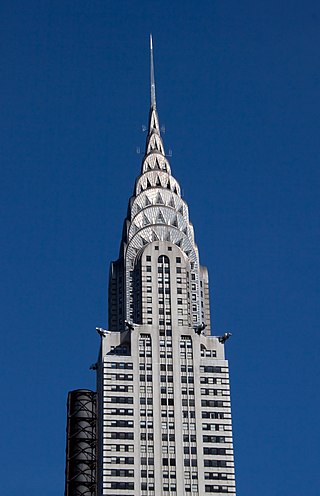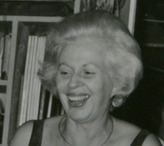
Art Deco, short for the French Arts Décoratifs, and sometimes referred to simply as Deco, is a style of visual arts, architecture, and product design, that first appeared in France in the 1910s, and flourished in the United States and Europe during the 1920s and 1930s. Through styling and design of the exterior and interior of anything from large structures to small objects, including how people look, Art Deco has influenced bridges, buildings, ships, ocean liners, trains, cars, trucks, buses, furniture, and everyday objects like radios and vacuum cleaners.

Art Nouveau is an international style of art, architecture, and applied art, especially the decorative arts. The style is known by different names in different languages: Jugendstil in German, Stile Liberty in Italian, Modernisme in Catalan, and also known as the Modern Style in English. It was popular between 1890 and 1910 during the Belle Époque period, and was a reaction against the academic art, eclecticism and historicism of 19th century architecture and decoration. It was often inspired by natural forms such as the sinuous curves of plants and flowers. Other characteristics of Art Nouveau were a sense of dynamism and movement, often given by asymmetry or whiplash lines, and the use of modern materials, particularly iron, glass, ceramics and later concrete, to create unusual forms and larger open spaces.
Maurizio Cattelan is an Italian visual artist. Known primarily for his hyperrealistic sculptures and installations, Cattelan's practice also includes curating and publishing. His satirical approach to art has resulted in him being frequently labelled as a joker or prankster of the art world. Self-taught as an artist, Cattelan has exhibited internationally in museums and Biennials. In 2011 the Guggenheim Museum, New York presented a retrospective of his work. Some of Cattelan's better-known works include America, consisting of a solid gold toilet; La Nona Ora, a sculpture depicting a fallen Pope who has been hit by a meteorite; and Comedian, a fresh banana duct-taped to a wall.

Cartier International SNC, or simply Cartier, is a French luxury goods conglomerate that designs, manufactures, distributes, and sells jewellery, leather goods, and watches. Founded by Louis-François Cartier (1819–1904) in Paris in 1847, the company remained under family control until 1964. The company is headquartered in Paris and is a wholly owned subsidiary of the Swiss Richemont Group. Cartier operates more than 200 stores in 125 countries, with three Temples in London, New York, and Paris.

The Musée des Arts décoratifs is a museum dedicated to the exhibition and preservation of the decorative arts. Located at 107 Rue de Rivoli in the 1st arrondissement of Paris, the museum occupies the most north-western wing of the Louvre Palace, known as the Pavillon de Marsan. With over one million objects in its collection, the Musée des Arts décoratifs is the largest museum of decorative arts in continental Europe.

Philippe Apeloig is a French graphic designer and typographer born in Paris in 1962.

The Royal Collection of the British royal family is the largest private art collection in the world.

Geoffrey Charles Munn, OBE, MVO, FSA, FLS is a British jewellery specialist, television presenter and writer. He is best known as one of the experts on the BBC's Antiques Roadshow.
Mel Lindquist was an American engineer and renowned pioneer of the American Studio Wood Turning movement.
Fiona Tan is a visual artist primarily known for her photography, film and video art installations. With her own complex cultural background, Tan's work is known for its skillful craftsmanship and emotional intensity, which often explores the themes of identity, memory, and history. Tan currently lives and works in Amsterdam, the Netherlands.

Fauvism /ˈfoʊvɪzm̩/ is the style of les Fauves, a group of early 20th-century modern artists whose works emphasized painterly qualities and strong colour over the representational or realistic values retained by Impressionism. While Fauvism as a style began around 1904 and continued beyond 1910, the movement as such lasted only a few years, 1905–1908, and had three exhibitions. The leaders of the movement were André Derain, Maurice de Vlaminck, and Henri Matisse.
Jane Dodd is a New Zealand musician and contemporary jeweller. From 1982 to 1984 she studied for a Bachelor of Arts at the University of Otago, majoring in Phenomenology of Religion with additional papers in Anthropology, History, Art History, Maori Language and Philosophy. She is well known for her role as a bass player in early Dunedin-based Flying Nun Records groups The Chills and The Verlaines, was a long-standing member of Auckland group Able Tasmans, and occasionally played with side-project The Lure of Shoes.

June Schwarcz was an American enamel artist who created tactile, expressive objects by applying technical mastery of her medium to vessel forms and plaques, which she considers non-functional sculpture.

Portrait of Baudouin de Lannoy is a small oil-on panel portrait by the Early Netherlandish painter Jan van Eyck, completed c. 1435. It shows Baldwin of Lannoy, a contemporary Flemish statesman and ambassador for Philip the Good at the court of Henry V of England. From surviving documents it is known that the work was commissioned to mark his entry into the order Baudouin de Lanno. He is in a formal pose, holding a wooden stick in his right hand, and a gold ring on his little finger. Van Eyck's surviving early portraits typically show the sitter holding an emblem of his profession and class.
Susie Ganch is a first generation American artist of Hungarian heritage. She is a sculptor, jeweler, educator, and founder and director of Radical Jewelry Makeover. Ganch received her Bachelors in Science from the University of Wisconsin-Madison in Geology in 1994 and her Masters in Fine Arts from the University of Wisconsin-Madison in 1997.
Grazia Varisco is an Italian visual artist and designer.

Alma Rosalie Eikerman was an American metalsmith, silversmith, and jewelry designer who was instrumental in building the metals program at Indiana University, of which she retired Distinguished Professor Emeritus. She was a founding member of the Society of North American Goldsmiths and studied under several internationally renowned metalsmiths, such as Karl Gustav Hansen. Eikerman's work has appeared in over 200 exhibitions, including Objects: USA at the Smithsonian Institution.

Julia deVille is a New Zealand-born artist, jeweller and taxidermist, who only uses subjects in her taxidermy that have died of natural causes. She lives and works in Australia.
Marilyn da Silva is an American sculptor, metalsmith, jeweler, and educator. She teaches and serves as a department head at the California College of the Arts in the San Francisco Bay Area. Da Silva has won numerous awards including honorary fellow by the American Craft Council (2007).
Matthias Ostermann (1951-2009) was a Canadian potter, artist and author.













